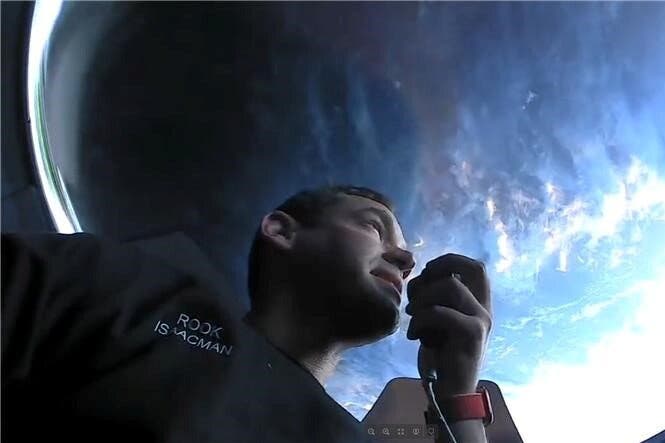Several space tourists have travelled to the International Space Station and even orbited the Earth for three days in their own space capsule. Now, a group of private astronauts wants to undertake a spacewalk, which is considered to be one of the most perilous things anybody has ever done while travelling in space.
Four private astronauts, including Jared Isaacman, the millionaire who booked SpaceX’s first space tourist voyage last year, may be sent into orbit as early as the end of this year aboard the company’s Crew Dragon spacecraft. It is expected that at some point during their five-day journey around the Earth, at least one of the astronauts would leave the spacecraft for what would be the first spacewalk undertaken by a non-government astronaut.
When it comes to spacewalking, Sandra Magnus, a retired NASA astronaut, says it is “the most dangerous thing that we do as astronauts.” Magnus operated the robotic arm of the International Space Station in 2002 while other astronauts carried out extravehicular activities, which is NASA’s term for spacewalks. “You’re in a one-person spacecraft, tethered to the exterior of your vehicle by a cable,” she said, referring to the astronauts’ hefty protective spacesuits.
The trip is to be the first in a programme dubbed Polaris, unveiled on Monday by SpaceX and Mr. Isaacman. According to a press release issued by the project, the primary objectives of Polaris are to “show new technology” and “perform substantial study” on the planet. Additionally, Mr. Isaacman will collaborate with SpaceX on two future Polaris missions: a second mission in the coming years aboard Crew Dragon, the spacecraft that NASA uses to transport astronauts to the International Space Station, and a third mission that would use Starship, the massive next-generation rocket system that SpaceX is developing.
While Mr. Isaacman, the founder of Shift4, a payments processing system, declined to disclose how much he was paying for any of the flights, Mr. Isaacman stated that the flights, like Inspiration4, were intended to raise money for St. Jude Children’s Research Hospital. Inspiration4 is a mission that Mr. Isaacman chartered in September 2021.
Besides Mr. Isaacman, he will be travelling with three other people: Scott Poteet, a retired Air Force pilot who served as mission director for the Inspiration4 mission; Sarah Gillis, a SpaceX engineer who is in charge of the company’s astronaut training programme; and Anna Menon, another SpaceX engineer who is a flight director in the company’s mission control.
Assuming the Polaris mission goes as planned, Ms. Menon would reach space before her husband Dr. Anil Menon, who was selected by NASA as an astronaut candidate last year and was formerly the company’s former medical director.
When astronauts go on spacewalks, they put their lives in tremendous danger. On the International Space Station, pairs of highly trained crew members don cumbersome white spacesuits before heading outside the orbiting laboratory to do maintenance and repairs on the outside of the space station’s structure. Before leaving the relative safety of the space station, they must pass through an airlock, which is a tiny compartment that steadily depressurizes its atmosphere until it approaches the near vacuum of orbit.
A spacewalk has never resulted in the death of an astronaut. But in 2013, a blocked filter allowed water to enter the helmet of Luca Parmitano, an Italian astronaut for the European Space Agency, during a journey to the station’s outside.
While Mr. Isaacman’s suggested trip would include a spacewalk, the process would be different from that used by NASA on the space station. The capsule, in contrast to the orbiting outpost, does not have an airlock. Instead, the whole Crew Dragon cabin will be depressurized before to the spacewalk, similar to the first American spacewalks that took place during Gemini, a NASA human spaceflight mission that took place before Apollo in the 1960s.
Ms. Menon stated that at least one of the astronauts would take part in the spacewalk, but she did not specify which astronaut it would be. Due to the lack of a protective atmosphere in their capsule, all four astronauts would be need to don new SpaceX spacesuits, which are presently in production, in order to be safe from the near vacuum throughout the event. In the course of SpaceX’s astronaut missions, there have been no accidents that have necessitated the use of live-fire testing of the company’s custom flight suits, which are designed to keep a person alive in space for a few hours in the event of an emergency.
The addition of spacewalking capabilities for non-government astronauts highlights the enormous amount of danger — and freedom — that commercial space businesses may accept in a sector that has no safety standards after a vessel carrying private astronauts reaches orbit.
While the Federal Aviation Administration supervises launch site safety, no government on Earth regulates the safety of commercial enterprises such as SpaceX’s spacewalking aspirations. Congress enacted a moratorium on spaceflight rules in 2004, which has been renewed many times, most recently until 2023. Space tourists are required to sign “informed consent” papers, which confirm that they are aware of the hazards associated with space travel. That pause in safety regulations is meant by politicians to enable the embryonic space sector to evolve.
“We want the commercial industry to be successful,” Dr. Magnus expressed his desire. The U.S. supervision function, however, continues to be a deficit, and it is unclear how we can bridge this gap in the future. How far ahead are we going to go before it is fixed?”

